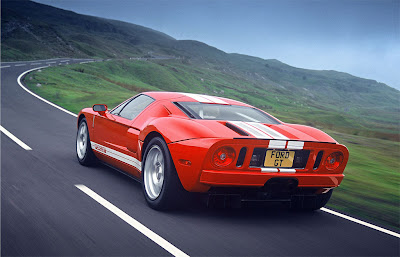
 The Ford GT began as a concept car designed in anticipation of Ford's centennial year and as part of its drive to showcase and revive its "heritage" names such as Mustang and Thunderbird. Camilo Pardo, the head of Ford's "Living Legends" studio, is credited as the chief designer of the GT and worked under the guidance of J Mays. The designers drew inspiration from Ford's classic GT40 race cars of the 1960s and the GT is sometimes mistaken for its 1960s counterpart.
The Ford GT began as a concept car designed in anticipation of Ford's centennial year and as part of its drive to showcase and revive its "heritage" names such as Mustang and Thunderbird. Camilo Pardo, the head of Ford's "Living Legends" studio, is credited as the chief designer of the GT and worked under the guidance of J Mays. The designers drew inspiration from Ford's classic GT40 race cars of the 1960s and the GT is sometimes mistaken for its 1960s counterpart. Today, the all-new 2005 Ford GT supercar comes to life in the form of three production road cars that honor the classic race cars in design and engineering ingenuity. Ford’s “Centennial Supercar” builds on the company’s product-led transformation and will be the flagship of Ford Division’s 2004 “Year of the Car” that will include the launches of the Ford Five Hundred sedan, Freestyle crossover and legendary Mustang – and then the Ford Futura mid-size sedan in 2005.
Today, the all-new 2005 Ford GT supercar comes to life in the form of three production road cars that honor the classic race cars in design and engineering ingenuity. Ford’s “Centennial Supercar” builds on the company’s product-led transformation and will be the flagship of Ford Division’s 2004 “Year of the Car” that will include the launches of the Ford Five Hundred sedan, Freestyle crossover and legendary Mustang – and then the Ford Futura mid-size sedan in 2005. “The Ford GT is our Centennial Supercar because it reaches into great moments from our past, while casting a light into the future,” said Chris Theodore, vice president, Ford Advance Product Creation. “As we celebrate our centennial, the Ford GT represents many of the technologies, processes and people that will help drive our next 100 years.”
“The Ford GT is our Centennial Supercar because it reaches into great moments from our past, while casting a light into the future,” said Chris Theodore, vice president, Ford Advance Product Creation. “As we celebrate our centennial, the Ford GT represents many of the technologies, processes and people that will help drive our next 100 years.”
Innovative Engineering
The Ford GT features many new and unique technologies, including super-plastic-formed aluminum body panels, roll-bonded floor panels, a friction-stir welded center tunnel, a “ship-in-a-bottle” gas tank, a capless fuel filler system, one-piece door panels and an aluminum engine cover with a one-piece carbon-fiber inner panel. Braking is handled by four-piston aluminum Brembo monoblock calipers with cross-drilled and vented rotors at all four corners. When the rear canopy is opened, the rear suspension components and engine become the car’s focal point. Precision – cast aluminum suspension components and 19-inch Goodyear tires – combined with the overwhelming presence of the V-8 engine – create a striking appearance and communicate the performance credentials of the Ford GT.
Braking is handled by four-piston aluminum Brembo monoblock calipers with cross-drilled and vented rotors at all four corners. When the rear canopy is opened, the rear suspension components and engine become the car’s focal point. Precision – cast aluminum suspension components and 19-inch Goodyear tires – combined with the overwhelming presence of the V-8 engine – create a striking appearance and communicate the performance credentials of the Ford GT. The 5.4L powerplant is all-aluminum and fed by an Eaton screw-type supercharger. It features four-valve cylinder heads and forged components, including the crankshaft, H-beam connecting rods and aluminum pistons. The resulting power output is 500 horsepower and 500 foot-pounds of torque.
The 5.4L powerplant is all-aluminum and fed by an Eaton screw-type supercharger. It features four-valve cylinder heads and forged components, including the crankshaft, H-beam connecting rods and aluminum pistons. The resulting power output is 500 horsepower and 500 foot-pounds of torque. The power is put to the road through a Ricardo six-speed manual transaxle featuring a helical limited-slip differential.
The power is put to the road through a Ricardo six-speed manual transaxle featuring a helical limited-slip differential. Video Ford GT
Video Ford GT
Saturday, October 20, 2007
Ford GT
Posted by Hammond R. at 6:20 AM
Subscribe to:
Post Comments (Atom)


0 comments:
Post a Comment